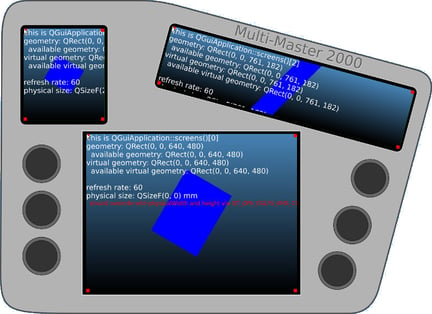
The new Emulator 3.0 will address the need to simulate devices with multiple screens. For example, these are present in the dashboards in modern cars.
Multi-screen support
Modern cars have multiple screens on their dashboard. To ease development of applications utilizing multiple screen the emulator has a new multi-screen feature which allows you to emulate devices having multiple screens. In the mockup file, which is now QML based you can declare several displays.
Applications can use one or more screens at the same time.
For every screen your application has to create a separate QQuickView.
for (auto screen : QGuiApplication::screens()) {
auto quickView = new QQuickView();
quickView->setScreen(screen);
quickView->setSource(QUrl("<file.qml>"));
quickView->showFullScreen();
}
Multi-point touch support
Touch and multi-point touch input is supported on all screens. Also the way it works is easier to use.
In multi point touch mode you start by clicking on the screen to add as many touch points as needed.
Starting a left click drag on one of the points will perform a swipe gesture using all of the points while a right click drag will perform a pinch gesture around the average center of all points.

Plugin Interface
The API for plugins has been simplified. Some parts of the emulator itself are also shipped as plugins as well.
This allows you to provide your own controls in the UI or handle custom communications with a client running inside
the virtual machine.
Mockup is QML
The mockup design done in QML and allows to add sophisticated custom controls more easily. Components like screens and terminals can be handles like regular QML components.
Product information
The Emulator 3.0 is part of Qt for Device Creation within Qt 5.10.



